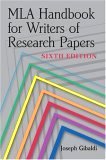

 Reference Site Map |
|
|
Links to related pages:
How to Write Footnotes and Endnotes in MLA Style
Footnotes and Endnotes - Examples in MLA Style
How to Write Parenthetical References - Examples in MLA Style
Works Cited, References, and Bibliography - What's the Difference?
Guidelines on How to Write a Bibliography in MLA Style
Bibliography Examples in MLA Style
Quoting Passages Using MLA Style
Footnotes in MLA Style - Sample Page
Endnotes in MLA Style - Sample Page
Parenthetical References in MLA Style - Sample Page
Works Cited in MLA Style - Sample Page
Research, Writing, and Style Guides (MLA, APA, Chicago/Turabian, Harvard, CGOS, CBE)
For a detailed treatment on quoting poetry or prose, please use the official MLA Handbook:

This Webpage provides only simple illustrations for a few common quotations. For the different placements of sentence periods under varying circumstances, please see sections 3.7.2. Prose, 3.7.3. Poetry, 3.7.4. Drama, 3.7.5. Ellipsis, and 6.3 Readability in the MLA Handbook.
1. If there is an obvious error in the quoted passage, add (sic) (Latin meaning "thus") after the error, e.g., "The theraputic (sic) remarks upset the patient immensely" (Morley 24).
2. To emphasize a passage you may italicize, bold, or underline it, but you must add (italics mine) or (emphasis added) in parentheses after the passage emphasized, e.g., "My job is the best job (italics mine) there is" (Gates 147). Or, "My job is the best job (emphasis added) there is" (Gates 147).
In the MLA Handbook, however, Gibaldi finds that it is rarely appropriate to use italics for emphasis in writing research papers (95) and that "In research papers and manuscripts submitted for publication, words that would be italicized in print are best underlined" (94).
3. To quote 1 or 2 lines of verse, poem, or poetry, you may use a back slash (/) to mark the end of the first line, e.g., In "Logan Braes," John Mayne writes: "Revered by friends, and far frae faes, / We'd live in bliss on Logan Braes" (363).
4. To quote 4 or less lines of prose, you can include the passage within quotation marks as part of your text, e.g. Dick Oliver concludes that "all communication industries [. . .] are moving rapidly toward exclusively digital technology" (24).
5. To quote 5 or more lines of prose, or 3 or more lines of verse, begin on a new line, set the quoted passage off from the text of your essay by indenting 1" (2.5 cm) or about 10 spaces from the left margin, double-space between lines, without using quotation marks.
Example:
In their Introduction to Computer Science with C++, Lambert, Nance, and Naps
stress that:
The key to writing a successful program is planning. Good programs
do not just happen: they are the result of careful design and
patience. [. . .]. Writing a program is like writing an essay:
An overall theme is envisioned, an outline of major ideas is
developed, each major idea is subdivided into several parts,
and each part is developed using individual sentences (15).
6. To omit part of a quoted passage, you need to indicate the omission by the use of 3 spaced dots enclosed in square brackets, e.g., "The local politicians believe welfare [. . .] should all be paid for through income taxes" (Stewart 1).
7. If your omission is at the end of the sentence, i.e. with an ellipsis at the end, there will be a total of four dots (3 spaced dots enclosed in square brackets followed by a period immediately outside the square brackets, and no period at the end of the parentheses), e.g., "Africa is more than warlords and tyrants [. . .]." (De Villiers and Hirtle 15)
8. If you are quoting 3 or more lines of verse but want to omit one or more full lines, indicate the omission by a single line of spaced dots across the page, enclosed in square brackets, e.g.,
[. . . . . . . . . . . . . . . . . . . . . . . . . . . . .]
9. To add a word or a remark to a quotation, or to replace a word or remark in the quotation, you must place your word or remark in square brackets [ ], e.g., "The child [Adam] was left miserably abandoned" (Price 206).